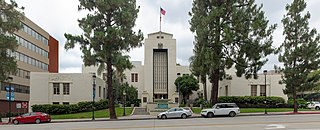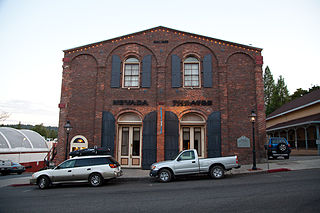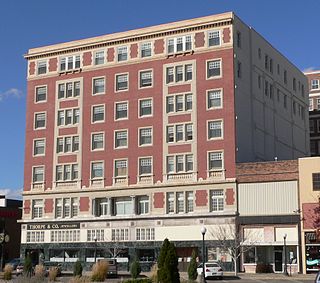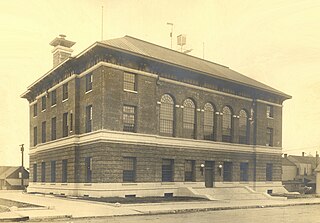
The Hawaii Theatre is a historic 1922 theatre in downtown Honolulu, Hawaii, located at 1130 Bethel Street, between Hotel and Pauahi Streets, on the edge of Chinatown. It is listed on the State and National Register of Historic Places.

The Pellissier Building and adjoining Wiltern Theatre is a 12-story, 155-foot (47 m) Art Deco landmark at the corner of Wilshire Boulevard and Western Avenue in Los Angeles, California. The entire complex is commonly referred to as the Wiltern Center. Clad in a blue-green glazed architectural terra-cotta tile and situated diagonal to the street corner, the complex is considered one of the finest examples of Art Deco architecture in the United States. The Wiltern building is owned privately, and the Wiltern Theatre is operated by Live Nation's Los Angeles division.

The Alex Theatre is a landmark located at 216 North Brand Boulevard in Glendale, California, United States. It is currently owned by the city of Glendale and operated by SAS. The theater's capacity is 1,400.

The Normal Theater, also known as the Normal Theatre, is a cinema located in the downtown area of Normal, Illinois of the United States of America, which is located in McLean County. The theater closed for a time in the early 1990s but reopened in 1993 after being purchased and renovated by the town of Normal. It has since been in continuous operation, showing a mix of first run and classic films. The building has been on the National Register of Historic Places since July 25, 1997.

Veterans Memorial Auditorium is a performing arts theater in Providence, Rhode Island. Construction began in 1928 but was delayed by the Great Depression. The theater was finally completed in 1950.

The Aztec Theatre is a historic theater in downtown San Antonio, Texas, United States.

Burbank City Hall is the site of the municipal government of Burbank, California, and is listed on the National Register of Historic Places.

The Schubert Theatre is a theater located in Gooding, Idaho, United States. Built in 1920, it was listed on the National Register of Historic Places in 2004.

The Nevada Theatre, also known as the Cedar Theatre, located in downtown Nevada City, California, is California's oldest existing theater building. Its principal periods of significance were 1850–1874, 1875–1899, 1900–1924, and 1925–1949. It is situated on ancestral Nisenan land.

The Rialto Theater in Deer Lodge, Montana was built in 1921 with 720 seats. The Beaux Arts style theater featured extensive painted murals, artistic plaster designs, and a painted stage backgrounds. The distinctive exterior used white terra cotta and red roof tiles.

The Martin Hotel, erected as a Chicago style building in 1912, is located in Sioux City, Iowa. Added to the National Register of Historic Places in 1983, it is significant for its architecture, operating for many years as the Sheraton-Martin Hotel and now known as the Martin Tower Apartments.

The Tower Theatre for the Performing Arts is a historic Streamline Moderne mixed-use theater in Fresno, California. Built in 1939, it opened to the public on December 15, 1939, under the management of Fox West Coast Theater Corporation. The building was designed by S. Charles Lee, with its tower inspired by the "Star Pylon" at the 1939 New York World's Fair. The theater underwent a renovation and reopened as a performing arts center in 1990, after being closed as a repertory cinema in 1989 due to financial troubles.

The United States Post Office and Courthouse in Eureka, California is a courthouse of the United States District Court for the Northern District of California. Completed in 1910, this historic building was listed on the National Register of Historic Places in 1983. Its architecture, designed by James Knox Taylor, is mixed, reflecting several styles. It initially served as a customhouse, in addition to being a courthouse and post office.

The Westlake Theatre is a historic theater located in the Westlake section of Los Angeles, California, United States, adjacent to MacArthur Park. The theater was listed on the National Register of Historic Places in 2009.

The Cascade Theatre is a prominent example of the Art Deco style in Redding, California. The cinema was designed by J. Lloyd Conrich of San Francisco in 1934 for the Naify family, who operated the Golden State Theaters chain of movie theaters in northern California, which later became the United Artists Theaters. The new cinema was built in 1935 by Salih Brothers and opened on August 9 with 1348 seats. It was the first air conditioned public building in Redding. In 1979 the large house was subdivided into four smaller theaters, and in 1997 it closed. The Cascade Theatre reopened in 2004 after it was purchased by Southern Oregon University and the JPR Foundation. The house was restored to its original configuration and it is used as a community auditorium and arts center.

The Tivoli Theatre, also known as the Tivoli and the "Jewel of the South", is a historic theatre in Chattanooga, Tennessee, that opened on March 19, 1921. Built between 1919 and 1921 at a cost of $750,000, designed by famed Chicago-based architectural firm Rapp and Rapp and well-known Chattanooga architect Reuben H. Hunt, and constructed by the John Parks Company, the theatre was one of the first air-conditioned public buildings in the United States. The theatre was named Tivoli after Tivoli, Italy, has cream tiles and beige terra-cotta bricks, has a large red, black, and white marquee with 1,000 chaser lights, and has a large black neon sign that displays TIVOLI with still more chaser lights.

The Winnemucca Main Post Office, which is listed on the National Register of Historic Places as US Post Office—Winnemucca Main, is located at 4th and Melarkey Sts. in Winnemucca, Nevada and was built in 1921; it includes Classical Revival architecture and was listed on the National Register of Historic Places in 1990.

The Dixie Center for the Arts, also known as the Dixie Theater or simply the Dixie, is a theater-style venue located at 212 North Vienna Street in Ruston, Louisiana.

The Dothan Opera House is a historic performing arts venue in Dothan, Alabama. It was built in 1914–15 as a municipal auditorium by the growing town. Seating 800, it opened October 8, 1915, with a performance by a local orchestra. The building was designed by Atlanta architectural firm Morris & Morris in a blend of Classical Revival and Italianate styles. The first floor features three central arched entry doors, with a pair of arched windows on either side. The second story is dominated by Ionic pilasters, four in the center section, and three on each side. The pilasters support a limestone architrave beneath a denticulated cornice and parapet roof. On the parapet, in line with each column in the center section is a figurine of an opera singer. A mural painted on the backdrop of the stage depicts the building under construction and some of the more famous acts to have performed in the theater.

The Hardacre Theater is a historic building located in the central business district of Tipton, Iowa, United States. The theater was originally built as an opera house and its construction was funded by the estate of Jacob Hardacre. Hardacre was a member of a fraternal organization, the Independent Order of Odd Fellows (I.O.O.F.), and it was stipulated that the building was to be used for their functions as well. The theater was opened in 1914, and it was converted into a movie house in 1919. There is seating for 264 on the main floor and an additional 132 seats in the balcony. The present marquee was erected by the Iowa Neon Sign Company of Des Moines in 1948. The I.O.O.F. sold the theater to Louie and Virginia Cook in 1978. It continued to serve as a movie theater, and it hosted its own film festival until it closed in August 2013. The Hardacre Theater Preservation Association bought the theater in 2014. They are renovating the theater to accommodate digital movie equipment, to return it to a live performing arts theater, and to provide space to host community events. It was listed on the National Register of Historic Places in 2016.






















